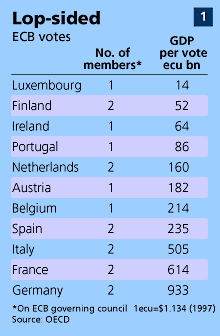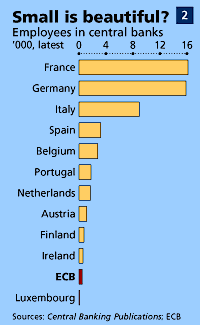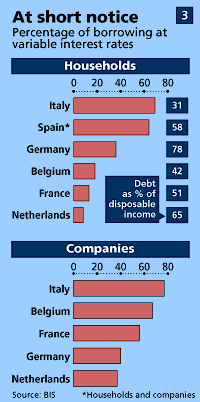EURO BRIEF
Euro Towers or Fawlty Towers?
The new European Central Bank (ECB) will be the most independent central bank in the world. But, as the third in our series of briefs on the euro explains, its task of setting monetary policy will be more than usually tricky
Banking on a
crisis?
The euro
Search archive
 |
|
A target or two
The ECB’s prime objective is laid down in the Maastricht treaty: price stability. In pursuance of this goal, the governing council will take decisions on interest rates by majority vote—just like the Bundesbank or America’s Federal Reserve. In the case of a tie, the ECB president will have the casting vote.
The ECB has agonised for months about what criteria to use in setting interest rates. The Bundesbank, in line with its own practice over the past 25 years, favoured a money-supply target, in which interest rates are changed to keep monetary growth within a specified range. But most independent economists have argued for an inflation target, as used by the Bank of England, among others.
The money supply is useful as a policy target only if there is a stable link between money and inflation. That has been hard to guarantee even in most national economies. In the euro area, the introduction of the single currency and the creation of an integrated financial market will change both the definition of the money supply and its relationship to inflation. The ECB still has a fearsome task trying to construct reliable euro-wide measures of inflation and money. Interpreting those numbers will be harder still.
Recognising this, the ECB has compromised and adopted not one, but two policy guides: a monetary target—or more precisely a “reference value”—and an inflation target of 2% or less. To monitor its performance against the inflation target, the ECB will use a basket of economic indicators, including an inflation forecast. Given the concerns about reliability of the data, this flexibility may make sense; but it could also cause confusion in financial markets.
The ECB’s main monetary instrument will be a repurchase (repo) rate. The ECB will ask the national central banks to conduct open-market operations to keep interest rates within its desired range. The ceiling will be the rate at which banks can borrow overnight from the central bank; the floor will be the rate at which banks with surplus cash deposit overnight funds.
In addition to this, and at Bundesbank insistence, the ECB will impose a minimum reserve requirement: banks must deposit at the central bank the equivalent of 2% of their outstanding loans. The Bundesbank believes that minimum reserve requirements give a central bank tighter control over bank lending and help to smooth out money-market interest rates. But unlike the Bundesbank, the ECB will at least pay a rate of interest on these bank deposits.
The ECB is thus unashamedly modelled upon the Bundesbank. But its statutes grant it even more freedom from political pressure. On paper, indeed, the ECB will be the most independent central bank ever. Not only does the Maastricht treaty prohibit it from taking orders from politicians, but members of the executive board are appointed for eight-year, non-renewable terms, insulating them from pressures to please politicians in order to get reappointed. National central-bank governors will have, at minimum, five-year contracts.
The ECB’s formal accountability to elected politicians or the public is more limited than that of other central banks. The chairman of America’s Fed testifies often before Congress. But there is no clear institutional context within which the ECB can answer for its actions. True, the president will be called before the European Parliament; and he will often attend meetings of euro-11 finance ministers. Yet the parliament lacks public credibility; and secret meetings of finance ministers hardly serve the purpose either.
On the face of it, this ought to make the ECB even more powerful. But the danger is that without proper accountability, it will find it much harder to win the sort of public support that the Bundesbank and the Fed have enjoyed. Already there are signs that some politicians will be quick to blame the ECB for all kinds of economic ills, such as persistent high unemployment.
A further possible source of political tension is exchange-rate policy. Although the ECB holds the monetary reins, the Maastricht treaty puts finance ministers in charge of exchange-rate policy for the euro. The risk is that their desired exchange-rate strategy could conflict with price stability. Recent calls from French and German politicians to “stabilise” the euro’s rate against the dollar (ie, to prevent it rising) have already strained relations between the politicians and the central bankers.
These concerns are no longer only theoretical. The political shift to the left across the EU, and especially in Germany, has made them all too real. Oskar Lafontaine, Germany’s new finance minister, seems to want the ECB’s remit to be widened to include growth as well as inflation; and he has also called for more expansionary fiscal policy. He has plenty of support, notably from his French counterpart, Dominique Strauss-Kahn, and from the new Italian government led by Massimo D’Alema. Rows between EU politicians and the ECB could get a lot worse if growth in the euro area slows sharply next year.
A flawed beginning
 |
|
Nor will the bank’s efforts to build credibility be helped by another design flaw: its decentralisation. The ECB will be less centralised than the Bundesbank or the Federal Reserve; national central banks will hold far more power. Eleven of the 17 members of the governing council represent the national central banks. In contrast, nine of the Bundesbank’s 17 council members are from the Land central banks; and only five of the 12 members of the Federal Reserve’s open-market committee are from district reserve banks.
Some economists worry that decentralisation could weaken the ECB. The governing council is supposed to set interest rates according to conditions in the euro area as a whole, but there is a risk that national governors will be unduly influenced by conditions in their home country.
Small countries may also carry undue weight in the system. As table 1 showed, Austria, Belgium, Finland, Ireland, Luxembourg, the Netherlands and Portugal will between them have nine of the 17 votes on the governing council (including members of the executive board), compared with Germany’s two, even though their combined GDP is only half of Germany’s.
The ECB will also be at a disadvantage in its resources, with a staff of only 500, compared with 53,000 staff at the 11 national central banks (see chart 2). The latter will continue to produce their own forecasts, which could cause confusion. A weak centre, combined with strong national interests, could create conflicts that undermine the whole system’s credibility.
The best defence against this would be maximum transparency. But the ECB has shown that it prefers to hide behind a veil of secrecy. It will not publish the minutes of its policy meetings, its inflation forecast (against which its actions could be judged), or the details of how members vote. When Mr Duisenberg was pressed on this by the European Parliament, he sardonically offered to release the minutes “after 16 years”.
The ECB argument is that confidentiality will protect individuals from pressure to vote in line with narrow national interests. But others argue that national interests may actually become more influential if votes are kept secret, because secrecy makes it easier for board members to vote with local interests, rather than euro-wide ones.
 |
|
The biggest uncertainty surrounds the links between interest rates, output and inflation. The fact that monetary union will start with countries at different stages of their economic cycle is bad enough: some economies, notably Ireland’s, are overheating, and need higher interest rates than Germany. But even if the economies were all at the same point of the cycle, there could still be a problem, because a given change in interest rates does not have a uniform effect in the 11 economies.
Can one size fit all?
Research by the IMF* finds that the effects of a rise in interest rates take twice as long to come through in Austria, Belgium, Finland, Germany, and the Netherlands as in France, Italy, Portugal and Spain. But the final impact is almost twice as large, on average, in the first group of countries as in the second.
This reflects different financial structures. Spanish banks pass on changes in interest rates to borrowers within three months; in Germany, even after 12 months, only three-quarters of any increase is passed on, because of closer relationships between banks and customers. Countries in which short-term or adjustable-rate debt is common, such as Italy, also respond faster to interest-rate changes than countries, such as Germany, where fixed-interest-rate debt dominates (see chart 3).
Over time the single currency should itself encourage these differences to narrow—but they will persist for some years, even so. Meanwhile, as one economist puts it, monetary policy will be a bit like “shooting at a moving target in the fog”. In a fog it helps to have a good compass. Yet, although the ECB’s two-pronged targets give it discretion, they will also breed uncertainty. Monetary policy works best if firms, households and financial markets understand exactly what a central bank is doing. A mixture of discretion and secrecy makes for a dangerous cocktail.
The ECB’s architects see the fact that it is modelled on the Bundesbank as a strength. And it is true that the Bundesbank has been the world’s most successful central bank, despite a certain lack of transparency. But that has more to do with Germany’s history and its social consensus in favour of low inflation. Without that, the ECB may face a tough battle in its early years. It will need all the weapons it can find—and there is none more powerful than transparency.
* “The Real Effects of Monetary Policy in the European Union”. IMF Working Paper No. 160. This article also draws on “The ECB: Safe at Any Speed?”, Centre for Economic Policy Research.